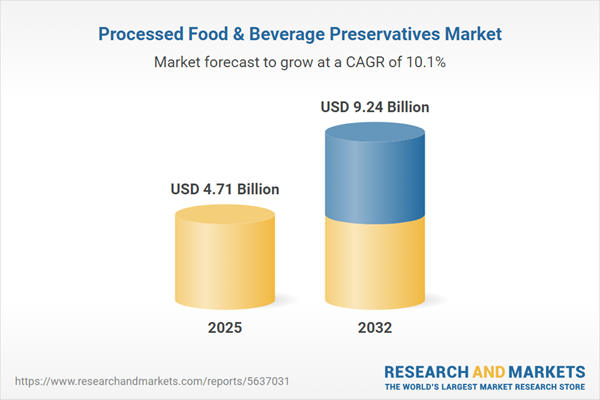Speak directly to the analyst to clarify any post sales queries you may have.
The processed food and beverage preservatives market is advancing as senior leaders pursue strategies to balance regulatory compliance, technology integration, and evolving consumer expectations for transparent, safe products. Organizations increasingly view this sector as critical for both risk mitigation and value creation.
Market Snapshot: Processed Food and Beverage Preservatives Market
In 2024, the global processed food and beverage preservatives market reached USD 4.28 billion, with projected growth to USD 4.71 billion for 2025 and a positive outlook extending to USD 9.24 billion by 2032. This expansion is primarily driven by updated regulatory frameworks, heightened consumer focus on food safety and extended shelf-life, and significant progress in preservation technologies. Executives are recalibrating strategies to foster compliance and product development, while ensuring operational flexibility to thrive in a landscape shaped by regulatory demands, shifting technologies, and greater consumer scrutiny.
Scope & Segmentation
- Preservative Types: Microbial-derived preservatives such as nisin and natamycin remain central for inhibiting spoilage and pathogenic threats. Plant-based solutions like ascorbic acid, rosemary extract, and tocopherols are increasingly favored by manufacturers aiming for clean label transparency. Synthetics including benzoates, parabens, propionates, sorbates, and sulfites continue to serve in high-demand scenarios requiring comprehensive protection and adaptability across food and beverage formats.
- Available Forms: Preservatives are produced in gels, granules, liquids, and powders, enabling customization within manufacturing processes to ensure uniform safety and consistent product quality across diverse applications.
- Distribution Channels: Manufacturers access preservatives through offline direct sales, established distributor partnerships, and growing digital procurement platforms, allowing rapid adaptation as regulatory and supply chain environments evolve.
- Applications: Preservation ingredients address requirements in bakery, beverages, confectionery, dairy, and meat, poultry, and seafood, supporting industry-wide compliance and consumer safety objectives.
- Regions Covered: The market spans the Americas, Europe, Middle East and Africa, and Asia-Pacific. Regulatory frameworks and adoption of innovations are especially influenced by regional dynamics in the United States, Germany, China, Brazil, India, South Africa, and Australia, fostering local adaptation and differentiated market approaches.
- Companies Profiled: Key participants such as International Flavors & Fragrances Inc., Kerry Group plc, Koninklijke DSM N.V., Chr. Hansen Holding A/S, Kemin Industries, BASF SE, Lonza Group AG, Corbion N.V., Tate & Lyle PLC, and Ajinomoto Co., Inc. demonstrate diverse capabilities in compliance adaptation, research leadership, and operational agility as they align with shifting sector priorities.
Key Takeaways
- Natural and plant-based preservative options continue to gain traction, reflecting demand for clean label ingredients and heightened transparency to meet modern compliance standards.
- Advanced delivery systems and encapsulation technologies are raising efficacy, enabling tighter control over preservative application and facilitating improvements in production workflows.
- Flexible procurement and supply chain strategies are vital as organizations counter disruption risks associated with evolving regulations and unpredictable global logistics scenarios.
- Sustainability commitments and transparent supply chain practices are shaping procurement and stakeholder engagement, enhancing trust and addressing rising regulatory requirements.
- Regional variations in technology adoption are significant: while Asia-Pacific and Latin America often apply established, cost-effective preservation methods, North America and Europe focus on lowering environmental impact and implementing greener solutions.
Tariff Impact: Navigating Cost Volatility and Strategic Adjustments
Recent tariffs applied to synthetic preservatives in the United States have increased operational expenses for processors. In response, organizations are expanding supplier networks, seeking regulatory relief, and examining plant-based alternatives. These actions help maintain continuity and minimize business risk as international trade policies remain uncertain.
Methodology & Data Sources
This analysis leverages direct interviews with industry suppliers and subject experts, ongoing industry monitoring, and robust quantitative studies. Additional reviews of academic research, patent filings, and recent regulatory changes ensure a trustworthy and actionable foundation for strategic decisions.
Why This Report Matters
- Empowers senior executives with insights to optimize procurement, anticipate changes, and adapt supply chains amid evolving regulatory and technological landscapes.
- Informs planned investment and innovation through a detailed understanding of sector drivers, competitor actions, and best practices engaged across leading organizations.
- Delivers targeted regional and competitor analysis that strengthens market entry, supports resource allocation, and aids risk management strategies.
Conclusion
Ongoing transformation in the processed food and beverage preservatives sector requires agile leadership and timely intelligence. Applying focused insights allows organizations to proactively address emerging trends, support compliance, and reinforce market position.
Additional Product Information:
- Purchase of this report includes 1 year online access with quarterly updates.
- This report can be updated on request. Please contact our Customer Experience team using the Ask a Question widget on our website.
Table of Contents
3. Executive Summary
4. Market Overview
7. Cumulative Impact of Artificial Intelligence 2025
Companies Mentioned
The companies profiled in this Processed Food & Beverage Preservatives market report include:- International Flavors & Fragrances Inc.
- Kerry Group plc
- Koninklijke DSM N.V.
- Chr. Hansen Holding A/S
- Kemin Industries, Inc.
- BASF SE
- Lonza Group AG
- Corbion N.V.
- Tate & Lyle PLC
- Ajinomoto Co., Inc.
Table Information
| Report Attribute | Details |
|---|---|
| No. of Pages | 190 |
| Published | October 2025 |
| Forecast Period | 2025 - 2032 |
| Estimated Market Value ( USD | $ 4.71 Billion |
| Forecasted Market Value ( USD | $ 9.24 Billion |
| Compound Annual Growth Rate | 10.0% |
| Regions Covered | Global |
| No. of Companies Mentioned | 11 |









